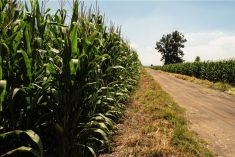Washington | Reuters –– U.S. farmers could plant more soybean acres than suggested in the government’s acreage forecast issued Thursday, as recent gains in the futures market tempted them to alter their corn-heavy seeding plans, growers and analysts said.
The U.S. Agriculture Department report showed farmers intend to plant 93.601 million acres of corn this spring, the third most since 1944. That forecast raised the prospect of adding more supplies to an already huge stockpile, sending corn prices into a tailspin and causing growers to question their seeding choices.
Read Also

U.S. grains: CBOT soybeans, corn, wheat fall in USDA data aftermath
Chicago grains took a dive on Friday, following a closely watched U.S. government crop report and the release of export data that could provide clues into Chinese buying.
“That might make a difference,” said Art Bunting, a farmer in Illinois who had planned on devoting 60 per cent of his acres to corn and 40 per cent to soybeans. “We might have to re-think what we are going to do. It might change some minds.”
Bunting said the sell-off made him consider switching two of his 80-acre fields to soybeans from corn.
USDA’s prospective plantings report, which also forecast soybean acreage dipping 0.5 per cent to 82.236 million acres, surveys farmers during the first two weeks of March. That leaves most growers with a month before they begin to put seeds in the ground.
Chicago Board of Trade November soybean futures, which track the crop that farmers will plant in the weeks ahead, rose 1.9 per cent during the last two weeks of March, piquing farmers’ interest after they finished their acreage surveys for the government. That compares with a 4.9 per cent drop in the CBOT December corn contract.
But a March soy rally has not always enticed farmers to boost their soybean acreage.
During the last 40 years, when soybean prices have posted gains that outperformed corn over the last two weeks of March, final soybean acreage has fallen an average of 615,615 acres from USDA’s prospective plantings forecast.
In the years when soybeans have posted last-half March gains greater than this year’s rally, soy acreage has declined an average of 377,462 acres from USDA’s outlook.
This year might be different, as the weak price environment has farmers facing steep losses for the crops they have yet to plant. Amid the poor profit prospects, many growers have delayed fertilizing their designated corn fields in a bid to cut costs.
“Going forward, that corn number is going to change,” said Brian Hoops, analyst at Midwest Market Solutions. “I just got off the phone with an Iowa farmer. He and his brother don’t have any anhydrous (fertilizer applied ahead of corn planting) down and are definitely looking to switch to soybeans.”
USDA said all-wheat seedings would be a smaller-than-expected 49.559 million acres, with the outlook for all classes except for durum falling below the low end of trade forecasts. Winter wheat acreage was pegged at 36.216 million, spring wheat (other than durum) acreage at 11.348 million and durum acreage at 1.995 million.
If realized, the other spring wheat acreage would be the lowest since 1972.
Wheat stocks as of March 1 were 1.372 billion bushels, a five-year high and up from 1.14 billion a year earlier. Analysts on average had expected quarterly wheat stocks of 1.356 billion bushels.
— Mark Weinraub is a Reuters correspondent covering grain markets based in Chicago. Additional reporting for Reuters by Michael Hirtzer in Chicago.













